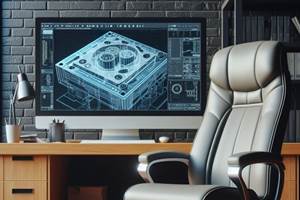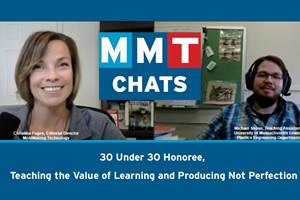Ed/Training - Invest in Employees to Become Globally Competitive
Coaching, leadership and mentoring should be considered for every individual in order to share in developing the company's strategic mission.
Every day the mold and die industry hears about the jobless recovery, lack of manufacturing jobs and export of high paying jobs. Productivity-the output per employee-is at an all-time high. What does this mean to our struggling mold and die manufacturing sector? For some it is doing more for less, squeezing margins to unsustainable low levels. For others it is doing more with less, operating with the thinnest of staff levels while putting further pressures on quality, safety and staff morale. The situation does not look to get better anytime soon. Economic growth and recovery will create more work, but the pressures of competition will continue to increase.
Advances in Technology
A key to increasing profits and maintaining competitveness against worldwide suppliers may lie in the marriage of process and resources, both human capital and fixed assets. The process used to develop molds, dies and tooling is well understood and has been readily duplicated. Against a backdrop of greatly reduced costs of equipment and plants to support this process, the barriers to entry have been shrinking, enabling low-cost producers to rapidly enter the market. Trying to compete on the basis of taking cost out of established processes is a proposition of diminishing returns at best. However, when looked at as a whole—plant, equipment, process and knowledge—there are opportunities to achieve significant competitive advantage.
The machine tool and software industries are introducing affordable new technologies that support higher productivity, single setup machining and higher finish capabilities. All can provide substantial productivity gains. New machinery and software are available worldwide, but do not provide an answer to the competitive pressure from low- cost overseas producers. When these advances in technology are married with the knowledge base of a highly skilled and deeply experienced workforce, the barrier for process duplication can be quite high. It is the entire process that combines physical assets with leverage of skill and knowledge of personnel assets that is unique and can be used as a competitive weapon. It is easy to acquire the newest plant equipment and machines, but quite a different matter to develop the personnel who are called upon to contribute with knowledge and judgment. Companies need to rapidly expand a knowledgeable workforce that understands the plant and equipment capability, end- customer needs and how to impact the process for improvement.
Success from Experience and Knowledge
The marriage of process and personnel assets works to great effect. One mold manufacturer has built his business on a process for lightweight molds of unique material composition. The process has been documented and attempted many times and does not make for the unique capabilities of this company. It is the experience and knowledge of making the process work for better end-customer products that has made it a success. This knowledge, focused on the total process is developed through all the personnel in the company. The company has invested heavily in the latest machine and software capabilities to provide the greatest flexibility. However, the key has been the everyday decisions made on the plant floor. They are training all of their staff to exercise judgment and experience on how to best achieve the most productive result for the end-customer using all the capabilities, machines and software at the company's disposal. Their training and development is more in line with asking the question of "How should we produce this part with these machines?" rather than "Here's how we make it" or "Here's how we program it." Every project is a new opportunity for productive gain. The empowerment has taken place on the floor, not in a management office.
The tools that have made this company so successful are embedded in unique skill sets, understanding of customer needs and empowerment. Their process is competitive and it is changing every day based on the current project. It is unlikely to be easily duplicated. This company ships finished tools worldwide, including China. The owner and founder says he is approached regularly on the prospects of licensing his process in other markets, particularly Asia. But how do you license a process that is developed based on years of experience with highly knowledgeable and educated personnel? This company has been extremely successful through the most difficult times and is taking its approach to ever-new markets. It competes not on machine capability, capacity or delivery, but rather on the total process and personnel.
Starting Strategies
How does a company move toward competing on process leveraged with human capital? It starts with an understanding of mission and strategy. Top management must set the mission and strategy to compete on a worldwide stage. It is not a simple decision or directive. It takes careful assessment of company strength, markets, weaknesses and assets, both plant and personnel. This must be communicated throughout the organization. In some cases training organizations can facilitate it, but leadership must come from within. Top management must be prepared to invest in the technologies or tools to provide, primarily, the flexibility to achieve the mission.
Ownership of the mission must be accepted at all levels. It is not about doing things the way you have done them before. It is all about how you explore all of your capabilities to the fullest to achieve superior results.
The role of training on the floor for most companies has largely been focused on enabling the productive use of new equipment or software. It is certainly important, but much more must be considered to fully leverage the knowledge and skill base. Investment in people beyond the minimum required to make the plant functional is a difficult hurdle for many. But as we have seen, the alternative may put long-term viability of the company at serious risk.
Any program to strengthen personnel assets should start with your best and brightest. In most industrial settings, mentoring should play a strategic role. It can focus on sharing and growing the experience and knowledge of your most skilled and talented workers across the organization. Training in the areas of coaching, leadership and mentoring should be considered for these key individuals and they must share in developing your strategic mission.
For the broader context of employee development, communication of the mission, understanding personal contribution opportunities and understanding the role of the mentor is of the essence. Small teams, led by a mentor with a charter to widen the operating envelope and think outside the box, can yield fast returns. A focused small-team effort, perhaps limited to a single cell, machine or part is not disruptive to overall plant operations. It is often the fastest track to broadening the knowledge base throughout the company. Training tools and programs to support employee development are available for most areas, such as communication, personal accountability, problem solving and customer awareness. Companies also can self-develop programs based on the skills of management and mentors, and company-specific needs. But all programs should aim at maximizing benefit from skills, knowledge and experience that already reside within the company and help share these essential soft assets toward achievement of the mission.
Your Future
Can such a program work? At no other time have the competitive threats posed by low-cost suppliers been on the top of management's concern about corporate survival while also topping the individual worker's concern about his or her job security and future.
Your workforce is more capable, more knowledgeable and more committed than that of any other region in the world. As long as modest but appropriate investment in your people is included along with technology and fixed asset investment, you have the opportunity to ensure the future.
Related Content
Making Quick and Easy Kaizen Work for Your Shop
Within each person is unlimited creative potential to improve shop operations.
Read MoreTackling a Mold Designer Shortage
Survey findings reveal a shortage of skilled mold designers and engineers in the moldmaking community, calling for intervention through educational programs and exploration of training alternatives while seeking input from those who have addressed the issue successfully.
Read MoreICYMI, MMT Chats: 30 Under 30 Honoree, Plastics Engineering TA Teaches Value of Learning and Producing Not Perfection
MoldMaking Technology Editorial Director Christina Fuges brings on UMass Lowell Plastics Engineering Teaching Assistant Michael Shone as a guest for this MMT Chat to discuss moldmaking through the lens of academia. This episode is brought to you by ISCAR with New Ideas for Machining Intelligently.
Read MorePredictive Manufacturing Moves Mold Builder into Advanced Medical Component Manufacturing
From a hot rod hobby, medical molds and shop performance to technology extremes, key relationships and a growth strategy, it’s obvious details matter at Eden Tool.
Read MoreRead Next
How to Use Continuing Education to Remain Competitive in Moldmaking
Continued training helps moldmakers make tooling decisions and properly use the latest cutting tool to efficiently machine high-quality molds.
Read MoreAre You a Moldmaker Considering 3D Printing? Consider the 3D Printing Workshop at NPE2024
Presentations will cover 3D printing for mold tooling, material innovation, product development, bridge production and full-scale, high-volume additive manufacturing.
Read More


















_300x250 1.png;maxWidth=300;quality=90)
.jpg;maxWidth=300;quality=90)
_300x250 4.png;maxWidth=300;quality=90)






